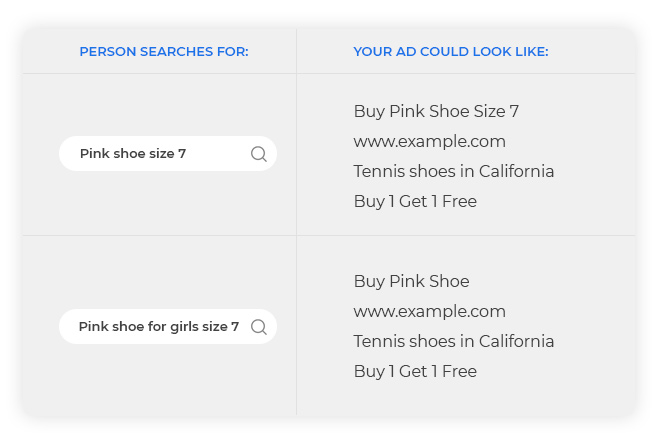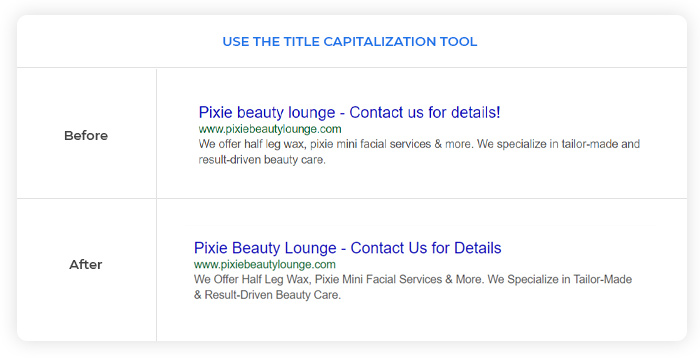[display-name-category]
[post_author]
[wtr-time]
We’ve updated this post! Click here to read our latest guide to crafting better ad copy to boost your Google Business Ads.
You have prepared everything required for your campaigns: the settings, ad groups, and keywords. Now, it’s time to start working on your ads. This means–writing ad copy!
For your PPC ads to flourish, it will be essential to learn to write excellent PPC ad copy. Many times our white label marketing partners had expressed they felt caught off guard when they heard this.
To ensure that marketing agencies tackle this task with confidence, our strategists have shared a list of Adwords best practices that make up the White Shark Media blueprint.
1.Include the Main Keyword in Your Headline
Simple and effective, use your ad group’s primary keyword in the headline to increase relevance. While managing PPC for business, the more relevant your ad is to the query, the more likely you will attract the right searchers and increase your click-through-rate (CTR).
2. Know Your Audience
We’re all different, and some consumers respond better to formal communication, while others will prefer a conversational tone. Pay close attention to your audience, and they will reveal their preferences.

For example, if your ideal audience is composed of high school students, your verbiage should be contemporary and “hip” to match their speaking way.
Advertising works best when the audience relates to the ad. That said, remember to also take into consideration what product or service you’re selling. If you are in the medical industry, you will want to maintain a degree of professionalism despite your audience’s demographics.
3. Make Good Use of your Description Lines
The next thing to take advantage of is the description line. This section showcases what sets you apart from the crowd.
Do you have excellent service, a fast delivery time, a price matching guarantee? Feature your benefits and unique selling points to the people who are eager to know them. Be creative about it!
Use common tactics to encourage purchases or ‘seal the deal.’ You’ll note that many ads offer Free Shipping on orders over a certain number of units, overnight shipping, while others describe the essential features of the products they carry.
4. Choose a Relevant Call-to-Action
A CTA (also known as call-to-action) is commonly placed at the end of an ad. They are strategically included at the end to entice or trigger a desirable action.
If you are an e-commerce-based company, you will want people to purchase your product online. You’ll most likely use a classic CTA like “Buy Now!”
If you’re looking to add a mix of terms to your list, here are other calls-to-action that you can consider using:

Aim to align your CTAs with where your prospects are in the buying funnel. If they’re not ready to buy now, then avoid using purchase CTAs. Instead, focus on more informative actions such as “Read More,” “Get More Info,” or “Find Out More.”
5. Use Exclamation Marks
We use the exclamation mark to express alarm, surprise, or urgency.
However, in the case of Google Ads, it’s one of the only visual symbols to indicate an increase of “volume” of the ads’ voice.’ Google seems to know how useful this symbol is in capturing attention, which is why we are limited to using it once within the description lines and never within the headline or display URL.
Take caution in which part of your ad you want to highlight with the exclamation symbol. Our best recommendation is often to use this within your call-to-action to incite an immediate response.
6. Squeeze More Text By Using Numbers & Abbreviations
PPC copywriters have to learn to be savvy with their wording. PPC ad copy has character limitations they must abide by for the ad to be approved. Some standard Google Ads best practices to keeping it simple:
Replace “and” with “&” when appropriate to save yourself two full character spaces. This tip is one of those AdWords best practices that you can set in stone.
Get familiar with proper abbreviations to buy yourself some space. For example, use SVC for services or Co. for company. If you don’t use commonly known abbreviations, you won’t get very far with made-up ones. Your audience will be left dazed and confused.
No matter the language, everyone understands numeric values. Use them! Don’t write out “Fifty Percent Off” when you can use “50% Off.” Besides, the numeric version is quicker to grasp and way more exciting to see. The faster your ad can prove compelling, the higher your chances are of getting that click.
7. Add Dynamic Keyword Insertion When Appropriate
Dynamic keyword insertion is a beneficial tool for increasing ad relevance for ad groups where there is a miscellaneous selection of search terms.
The ad group Pink Shoes – Sizes can have keywords such as:
- pink shoe size 7
- pink shoe size 6
By having an ad with the dynamic headline {KeyWord: Pink Shoe}, a searcher that uses the keyword “pink shoes size 6”, will see their search query in the headline of the ad.

However, if the search query is not an exact match to the keywords within your ad groups or it’s so long it passes the 30 character limit, we will still see our ad trigger for a “pink shoe” search query.
8. Impeccable Spelling & Grammar
PPC for business may be weighed down by poor grammar and spelling. Set up a QA process that double and triple-checks that there aren’t mistakes in your ads. Though it is excellent to use common phrases and contemporary slang, these kinds of errors will make your brand appear unprofessional.
9. Capitalize Every-Word Except For Articles
Inter-capitalization has proven to be very useful as a visual element. This simple enhancement can make your ads stand out, and the font seems more extensive than it is. Use this tip except when using the articles “a,” “and” & “the.”

10. Go Local
People like small and local businesses over big corporations. They are better acquainted with the business culture, beliefs, and people they meet at your stores. Use your ads to push your location and encourage people to “stop by.” These friendly visits are the first time to long time customers.
You don’t have to be exclusive to one location to push the local ads.
Create separate PPC campaigns for different geographical areas, adjusting specific location-based terms for each of your PPC for business campaigns.
You can also add local phone numbers to your ads for credibility.
Conclusion
We hope that the Google Adwords best practices whipped up by our strategists help you feel prepared to tackle your PPC ad copy. They are simple things to consider, and they will go a long way in helping your business thrive and reach the people interested in your products and services.
To stay in touch with more best practices and insights by our white label marketing strategists, follow our blog for weekly updates!
By having an ad with the dynamic headline {KeyWord: Pink Shoe}, a searcher who uses the keyword “pink shoes size 6” will see their search query in the ad’s headline.





